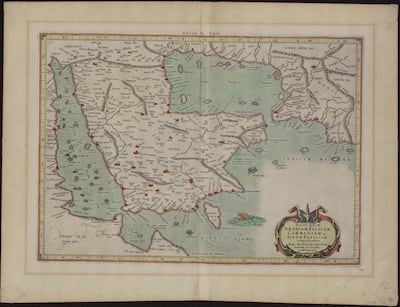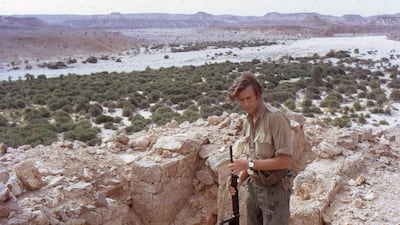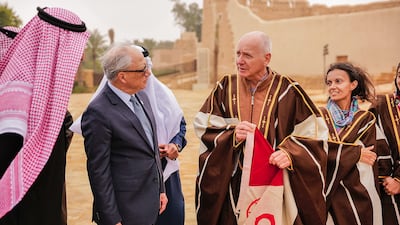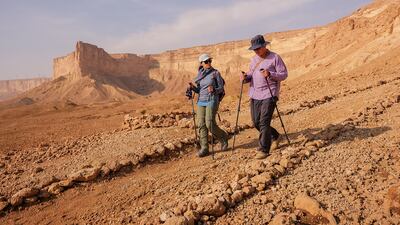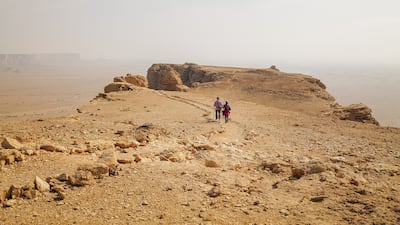For centuries, rumours swirled like a desert sandstorm of a city lost deep in the Empty Quarter of Arabia, half glimpsed but never quite reached, like a shimmering mirage.
Its name was Ubar, or Iram of the Pillars, once ruled by a tribe called the ‘Ad.
The Quran relates how the city was destroyed by God for abandoning the teachings of the Prophet Hud.
The Surah Al Fajir (The Dawn) asks “Hast thou not seen how thy Lord did with 'Ad, Iram of the Pillars, the like of which was never created in the land?"
It reveals: “Thy Lord unloosed upon them a scourge of chastisement; surely Thy Lord is ever on the watch.”
The story of Ubar, once fabulously wealthy and then destroyed, also appears in the tales of 1001 Arabian Nights, whose Arabic version is at least 1,000 years old.
In the translation by the 19th century British writer and explorer Sir Richard Burton, it is found by a man searching for a lost camel in the deserts of Al Yaman (Yemen) who comes across “a great city girt by a vast castle around which were palaces and pavilions that rose high into middle air”.
This, he later learns, is “Many-columned Iram,” the creation of “Shaddad, son of Ad, King of the world”. For his arrogance, Shaddad and his court are destroyed by God, who also obliterates the road to Iram, making it impossible to find.
In the 20th Century, serious efforts were made to discover the truth about Ubar. T E Lawrence, best known for his wartime exploits as Lawrence of Arabia, called it the “Atlantis of the Sands” and “a city of immeasurable wealth, destroyed by God for its arrogance, swallowed forever in the sands of the Rub al Khali desert“, but his proposal for an expedition was cut short by his death in a motorcycle accident in 1935.
Bertrand Thomas, a British diplomat and explorer, who was the first Westerner to cross the Rub’ al Khali or Empty Quarter, was at first convinced that Ubar was real when he encountered broad camel tracks near the desert’s southern edge.
As he recounted in his 1932 book of the expedition Arabia Felix, his Bedouin guides told him “There is the road to Ubar”, describing it as “a great city, our fathers have told us, that existed of old, rich in treasure, with date gardens and fort of red silver”.
Another British explorer, and advisor to Ibn Saud, Ruler of Saudi Arabia, was Harry St John Philby, who made another crossing of the Rub’ al Khali in the winter of 1932 and ’33.
Philby was also intrigued by Ubar, writing that: “There can be little or no doubt that the legendary city of the sands…is one and not many.”
Both Thomas and Philby eventually decided that Ubar never existed, with Philby writing: “So far as the Rub’ al Khali is concerned, it is a myth and no more.”
Hope remains for elusive discovery
The story, however, did not go away. In 1944, a Royal Air Force Lodestar transport plane, flying from Salalah, on the southern coast of Oman, to Muscat, became lost over Arabia.
Heading north, he found himself over the Empty Quarter, before, nearly out of fuel, landing at the RAF base in Sharjah.
There he told a story of seeing an abandoned city, hidden on the summit of a flat topped mountain, or mesa. Dropping to a lower altitude, the pilot saw large fortress-like structures and ruining buildings, but no sign of life.
That, at least, is the version retold by Raymond O’Shea, an airman at the base, who later published an account of his time in Sharjah, The Sand Kings Of Oman.
Fired up by the airman’s story, O’Shea used two weeks' leave to find the city, using the pilot’s co-ordinates and hiring local guides. It was not difficult. The site was just a few days into the desert from Liwa Oasis.
There, O’Shea, and a companion called Schultz, discovered the city exactly as described. Climbing to the summit of the hill he found two acres of crumbling sandstone ruins.
“Most of the buildings were a mass of rubble, so that it was difficult to distinguish houses or streets, but two of the towers were still standing; these measured 30 feet in circumference and 40 feet high… The walls themselves were in places four feet thick, the stone blocks ― the largest of which measured two feet in length and 18 inches in width ― being held together by a rough mortar made of gypsum and clay.”
Realising he was running out of water, and that Saudi Arabia was out of bounds for members of the British armed forces, he stayed only a few hours before returning to Sharjah.
O’Shea’s book was published in 1947, with a map triumphantly marking his discovery of “the lost city of ‘Ab”. It is fair to say it was not well received.
His description of Sharjah led to a complaint by the Ruler, while British officials called it “derogatory” and “full of the most appalling inaccuracies”.
More problematic was his “discovery” of the lost city. No rock formation resembling his hilltop could be found anywhere near his claimed location. Worse, a series of photographs of Ubar were quickly exposed as buildings in Muscat. Among the many critics was the explorer Wilfred Thesiger, who had recently completed his own crossing of the Empty Quarter.
A secret buried in the sands of time
O’Shea is not completely discredited. It Is possible he was mistaken about the location, while the Muscat photos had been the choice of his publisher, looking to add local colour.
In any event, Ubar remains as lost as it had ever been. Then, in 1982, an American documentary maker, Nicholas Clapp, began another search.
Clapp began looking not among the sands of the Rub al Khali, but in the University of California in Los Angeles. He suspected the real Ubar might be a city called Omanum Emporium, plotted on Ptolomy’s famous Second Century map of Arabia.
Omanum Emporium - the Latin for Omani Market- would have been a major trading stop on the incense caravan route from Arabia to the markets of Jerusalem, Damascus and Rome.
Next he turned to Nasa’s Jet Propulsion Lab with an audacious proposal to use a ground penetration radar on the Space Shuttle to detect ancient camel tracks long invisible to the human eye.
Nasa agreed, with the search eventually focusing on an oasis site called Shisur. This was not exactly a new discovery. Shisur, or Shisr, had been visited by American oil prospectors in the 1950s, who had also briefly looked for a lost city, but found nothing.
Both Thomas and Thesiger knew of the site, but believed it was only a few hundred years old.
Clapp thought there might be something more, and, in 1990, began to assemble an expedition that included Sir Ranulph Fiennes.
Arriving at Shisur they discovered there was more to the site than meets the eye. Below the ruins of fort, they found evidence of more extensive structures including walls and towers. Pottery fragments at least 2,000 years old dated the site.
This version of Ubar had not been destroyed by the wrath of God. Built over an underground cavern, the weight of the walls had created a giant sinkhole into which everything had collapsed.
Case closed? Clapp certainly believed so. So does the tourist board, which has place a sign proclaiming “Welcome to Ubar. Lost City of Bedouin Legend.”
Questions — and doubts ― still remain. Even at its height, the settlement at Shisur was not much more than a trading post, with a population likely to have been less than 200.
This is far from the “palaces and pavilions” that were “rich in treasure” of myth and legend. Perhaps Ubar, city of pillars, destroyed by God for its wickedness, is still to be discovered under the sands of the Empty Quarter.
Perhaps also, it is the nature of lost cities to remain forever undiscovered.
Heart of Arabia Expedition - in pictures
Naga
%3Cp%3E%3Cstrong%3EDirector%3A%C2%A0%3C%2Fstrong%3EMeshal%20Al%20Jaser%3C%2Fp%3E%0A%3Cp%3E%3Cstrong%3EStarring%3A%C2%A0%3C%2Fstrong%3EAdwa%20Bader%2C%20Yazeed%20Almajyul%2C%20Khalid%20Bin%20Shaddad%3C%2Fp%3E%0A%3Cp%3E%3Cstrong%3ERating%3A%20%3C%2Fstrong%3E4%2F5%3C%2Fp%3E%0A
The specs
Engine: 2-litre or 3-litre 4Motion all-wheel-drive Power: 250Nm (2-litre); 340 (3-litre) Torque: 450Nm Transmission: 8-speed automatic Starting price: From Dh212,000 On sale: Now
Company Fact Box
Company name/date started: Abwaab Technologies / September 2019
Founders: Hamdi Tabbaa, co-founder and CEO. Hussein Alsarabi, co-founder and CTO
Based: Amman, Jordan
Sector: Education Technology
Size (employees/revenue): Total team size: 65. Full-time employees: 25. Revenue undisclosed
Stage: early-stage startup
Investors: Adam Tech Ventures, Endure Capital, Equitrust, the World Bank-backed Innovative Startups SMEs Fund, a London investment fund, a number of former and current executives from Uber and Netflix, among others.
UPI facts
More than 2.2 million Indian tourists arrived in UAE in 2023
More than 3.5 million Indians reside in UAE
Indian tourists can make purchases in UAE using rupee accounts in India through QR-code-based UPI real-time payment systems
Indian residents in UAE can use their non-resident NRO and NRE accounts held in Indian banks linked to a UAE mobile number for UPI transactions
More from Neighbourhood Watch:
Tomb%20Raider%20I%E2%80%93III%20Remastered
%3Cp%3EDeveloper%3A%20Aspyr%0D%3Cbr%3EPublisher%3A%20Aspyr%0D%3Cbr%3EConsole%3A%20Nintendo%20Switch%2C%20PlayStation%204%26amp%3B5%2C%20PC%20and%20Xbox%20series%20X%2FS%0D%3Cbr%3ERating%3A%203%2F5%3C%2Fp%3E%0A
Results
5.30pm: Maiden (TB) Dh82,500 (Dirt) 1,600m, Winner: Panadol, Mickael Barzalona (jockey), Salem bin Ghadayer (trainer)
6.05pm: Maiden (TB) Dh82,500 (Turf) 1,400m, Winner: Mayehaab, Adrie de Vries, Fawzi Nass
6.40pm: Handicap (TB) Dh85,000 (D) 1,600m, Winner: Monoski, Mickael Barzalona, Salem bin Ghadayer
7.15pm: Handicap (TB) Dh102,500 (T) 1,800m, Winner: Eastern World, Royston Ffrench, Charlie Appleby
7.50pm: Handicap (TB) Dh92,500 (D) 1,200m, Winner: Madkal, Adrie de Vries, Fawzi Nass
8.25pm: Handicap (TB) Dh92,500 (T) 1,200m, Winner: Taneen, Dane O’Neill, Musabah Al Muhairi
Day 1, Abu Dhabi Test: At a glance
Moment of the day Dimuth Karunaratne had batted with plenty of pluck, and no little skill, in getting to within seven runs of a first-day century. Then, while he ran what he thought was a comfortable single to mid-on, his batting partner Dinesh Chandimal opted to stay at home. The opener was run out by the length of the pitch.
Stat of the day – 1 One six was hit on Day 1. The boundary was only breached 18 times in total over the course of the 90 overs. When it did arrive, the lone six was a thing of beauty, as Niroshan Dickwella effortlessly clipped Mohammed Amir over the square-leg boundary.
The verdict Three wickets down at lunch, on a featherbed wicket having won the toss, and Sri Lanka’s fragile confidence must have been waning. Then Karunaratne and Chandimal's alliance of precisely 100 gave them a foothold in the match. Dickwella’s free-spirited strokeplay meant the Sri Lankans were handily placed at 227-4 at the close.
EMILY%20IN%20PARIS%3A%20SEASON%203
%3Cp%3ECreated%20by%3A%20Darren%20Star%3C%2Fp%3E%0A%3Cp%3EStarring%3A%20Lily%20Collins%2C%20Philippine%20Leroy-Beaulieu%2C%20Ashley%20Park%3C%2Fp%3E%0A%3Cp%3ERating%3A%202.75%2F5%3C%2Fp%3E%0A
Ten tax points to be aware of in 2026
1. Domestic VAT refund amendments: request your refund within five years
If a business does not apply for the refund on time, they lose their credit.
2. E-invoicing in the UAE
Businesses should continue preparing for the implementation of e-invoicing in the UAE, with 2026 a preparation and transition period ahead of phased mandatory adoption.
3. More tax audits
Tax authorities are increasingly using data already available across multiple filings to identify audit risks.
4. More beneficial VAT and excise tax penalty regime
Tax disputes are expected to become more frequent and more structured, with clearer administrative objection and appeal processes. The UAE has adopted a new penalty regime for VAT and excise disputes, which now mirrors the penalty regime for corporate tax.
5. Greater emphasis on statutory audit
There is a greater need for the accuracy of financial statements. The International Financial Reporting Standards standards need to be strictly adhered to and, as a result, the quality of the audits will need to increase.
6. Further transfer pricing enforcement
Transfer pricing enforcement, which refers to the practice of establishing prices for internal transactions between related entities, is expected to broaden in scope. The UAE will shortly open the possibility to negotiate advance pricing agreements, or essentially rulings for transfer pricing purposes.
7. Limited time periods for audits
Recent amendments also introduce a default five-year limitation period for tax audits and assessments, subject to specific statutory exceptions. While the standard audit and assessment period is five years, this may be extended to up to 15 years in cases involving fraud or tax evasion.
8. Pillar 2 implementation
Many multinational groups will begin to feel the practical effect of the Domestic Minimum Top-Up Tax (DMTT), the UAE's implementation of the OECD’s global minimum tax under Pillar 2. While the rules apply for financial years starting on or after January 1, 2025, it is 2026 that marks the transition to an operational phase.
9. Reduced compliance obligations for imported goods and services
Businesses that apply the reverse-charge mechanism for VAT purposes in the UAE may benefit from reduced compliance obligations.
10. Substance and CbC reporting focus
Tax authorities are expected to continue strengthening the enforcement of economic substance and Country-by-Country (CbC) reporting frameworks. In the UAE, these regimes are increasingly being used as risk-assessment tools, providing tax authorities with a comprehensive view of multinational groups’ global footprints and enabling them to assess whether profits are aligned with real economic activity.
Contributed by Thomas Vanhee and Hend Rashwan, Aurifer
The National Archives, Abu Dhabi
Founded over 50 years ago, the National Archives collects valuable historical material relating to the UAE, and is the oldest and richest archive relating to the Arabian Gulf.
Much of the material can be viewed on line at the Arabian Gulf Digital Archive - https://www.agda.ae/en
Ibrahim's play list
Completed an electrical diploma at the Adnoc Technical Institute
Works as a public relations officer with Adnoc
Apart from the piano, he plays the accordion, oud and guitar
His favourite composer is Johann Sebastian Bach
Also enjoys listening to Mozart
Likes all genres of music including Arabic music and jazz
Enjoys rock groups Scorpions and Metallica
Other musicians he likes are Syrian-American pianist Malek Jandali and Lebanese oud player Rabih Abou Khalil
Voy!%20Voy!%20Voy!
%3Cp%3E%3Cstrong%3EDirector%3A%3C%2Fstrong%3E%20Omar%20Hilal%3Cbr%3E%3Cstrong%3EStars%3A%3C%2Fstrong%3E%20Muhammad%20Farrag%2C%20Bayoumi%20Fouad%2C%20Nelly%20Karim%3Cbr%3E%3Cstrong%3ERating%3A%3C%2Fstrong%3E%204%2F5%3C%2Fp%3E%0A
Student Of The Year 2
Director: Punit Malhotra
Stars: Tiger Shroff, Tara Sutaria, Ananya Pandey, Aditya Seal
1.5 stars
Key findings of Jenkins report
- Founder of the Muslim Brotherhood, Hassan al Banna, "accepted the political utility of violence"
- Views of key Muslim Brotherhood ideologue, Sayyid Qutb, have “consistently been understood” as permitting “the use of extreme violence in the pursuit of the perfect Islamic society” and “never been institutionally disowned” by the movement.
- Muslim Brotherhood at all levels has repeatedly defended Hamas attacks against Israel, including the use of suicide bombers and the killing of civilians.
- Laying out the report in the House of Commons, David Cameron told MPs: "The main findings of the review support the conclusion that membership of, association with, or influence by the Muslim Brotherhood should be considered as a possible indicator of extremism."
All%20We%20Imagine%20as%20Light
%3Cp%3E%3Cstrong%3EDirector%3A%20%3C%2Fstrong%3EPayal%20Kapadia%3C%2Fp%3E%0A%3Cp%3E%3Cstrong%3EStarring%3A%3C%2Fstrong%3E%20Kani%20Kusruti%2C%20Divya%20Prabha%2C%20Chhaya%20Kadam%3C%2Fp%3E%0A%3Cp%3E%3Cstrong%3ERating%3A%3C%2Fstrong%3E%204%2F5%3C%2Fp%3E%0A
'Cheb%20Khaled'
%3Cp%3E%3Cstrong%3EArtist%3A%20%3C%2Fstrong%3EKhaled%3Cbr%3E%3Cstrong%3ELabel%3A%20%3C%2Fstrong%3EBelieve%3Cbr%3E%3Cstrong%3ERating%3A%3C%2Fstrong%3E%204%2F5%3C%2Fp%3E%0A
Key facilities
- Olympic-size swimming pool with a split bulkhead for multi-use configurations, including water polo and 50m/25m training lanes
- Premier League-standard football pitch
- 400m Olympic running track
- NBA-spec basketball court with auditorium
- 600-seat auditorium
- Spaces for historical and cultural exploration
- An elevated football field that doubles as a helipad
- Specialist robotics and science laboratories
- AR and VR-enabled learning centres
- Disruption Lab and Research Centre for developing entrepreneurial skills
Spider-Man%202
%3Cp%3E%3Cstrong%3EDeveloper%3A%3C%2Fstrong%3E%20Insomniac%20Games%0D%3Cbr%3E%3Cstrong%3EPublisher%3A%3C%2Fstrong%3E%20%20Sony%20Interactive%20Entertainment%0D%3Cbr%3E%3Cstrong%3EConsole%3A%20%3C%2Fstrong%3EPlayStation%205%0D%3Cbr%3E%3Cstrong%3ERating%3A%3C%2Fstrong%3E%205%2F5%3C%2Fp%3E%0A
CHATGPT%20ENTERPRISE%20FEATURES
%3Cp%3E%E2%80%A2%20Enterprise-grade%20security%20and%20privacy%3C%2Fp%3E%0A%3Cp%3E%E2%80%A2%20Unlimited%20higher-speed%20GPT-4%20access%20with%20no%20caps%3C%2Fp%3E%0A%3Cp%3E%E2%80%A2%20Longer%20context%20windows%20for%20processing%20longer%20inputs%3C%2Fp%3E%0A%3Cp%3E%E2%80%A2%20Advanced%20data%20analysis%20capabilities%3C%2Fp%3E%0A%3Cp%3E%E2%80%A2%20Customisation%20options%3C%2Fp%3E%0A%3Cp%3E%E2%80%A2%20Shareable%20chat%20templates%20that%20companies%20can%20use%20to%20collaborate%20and%20build%20common%20workflows%3C%2Fp%3E%0A%3Cp%3E%E2%80%A2%20Analytics%20dashboard%20for%20usage%20insights%3C%2Fp%3E%0A%3Cp%3E%E2%80%A2%20Free%20credits%20to%20use%20OpenAI%20APIs%20to%20extend%20OpenAI%20into%20a%20fully-custom%20solution%20for%20enterprises%3C%2Fp%3E%0A
The specs
Engine: 4 liquid-cooled permanent magnet synchronous electric motors placed at each wheel
Battery: Rimac 120kWh Lithium Nickel Manganese Cobalt Oxide (LiNiMnCoO2) chemistry
Power: 1877bhp
Torque: 2300Nm
Price: Dh7,500,00
On sale: Now
FINAL SCORES
Fujairah 130 for 8 in 20 overs
(Sandy Sandeep 29, Hamdan Tahir 26 no, Umair Ali 2-15)
Sharjah 131 for 8 in 19.3 overs
(Kashif Daud 51, Umair Ali 20, Rohan Mustafa 2-17, Sabir Rao 2-26)


